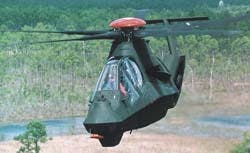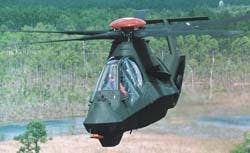Army asks ITT to continue development of Comanche helicopter electronic warfare systemU.S. Army communications experts needed engineering services for the design of a new electronic warfare system for the future RAH-66 Comanche scout-attack helicopter. They found their solution from the ITT Avionics Division in Clifton, N.J.
Army Communications-Electronics Command (CECOM) officials at Fort Monmouth, N.J., awarded ITT a $24.3 million contract for engineering and support services including studies and evaluations for the Suite of Integrated Radio Frequency Countermeasures, AN/ALQ-211(V) Program — better known as SIRFC.
The ALQ-211(V) is a radar warning receiver subsystem, a variant of the AN/ALQ-211. The ALQ-211(V)3 is a stand-alone radar-warning receiver that will provide high precision direction finding capabilities to the Comanche. ITT is producing the ALQ-211(V)3 system together with engineers at BAE Systems.
The overall AN/ALQ-211 system provides radar warning, situational awareness, and electronic countermeasures, and will help aircrews detect, evade, and defeat modern and emerging air defense threats, ITT officials say.
The AN/ALQ-211 system is the overall electronic warfare suite manager, ITT officials say. It fuses on- and off-board sensor threat data, which provides the pilot with a real-time picture of the battlefield and allows the aircrew to evade multi-spectral threats. SIRFC coordinates the appropriate RF or IR countermeasures and the dispensing of chaff or flare.
Variants of the AN/ALQ-2ll also are going aboard the U.S. Army's AH-64D Apache Longbow attack helicopter, the Special Operations MH-60K helicopter, MH-47E helicopter, and the Air Force Special Operations CV-22 tiltrotor aircraft. — J.K.
For more information contact ITT Avionics by phone at 973-284-3178, by post at 100 Kingsland Road, Clifton, N.J., 07014-1996, or on the World Wide Web at http://www.ittavionics.com/.
•ComputersGeneral Dynamics to demonstrate data fusion for Army helicopter pilotsU.S. Army officials needed ideas on how data fusion technology can integrate radar, missile, and laser threat-warning data with other digital battlefield information to improve the situational awareness of Army helicopter crews.
The Quarterback data-fusion software from General Dynamics Electronic Systems in Mountain View, Calif., met their needs.
Leaders of the Army Communications-Electronics Command at Fort Monmouth, N.J., awarded General Dynamics a $7.8 million two-year advanced technology demonstration contract to to demonstrate Quarterback's combat value — including improved combat identification, situation awareness, and targeting.
If successfully demonstrated, the Army could develop and field an operational system under a separate contract, company officials say. General Dynamics will lead a team that includes ITT Industries, BAE Systems, and BF Goodrich.
Under the Integrated Situational Awareness and Targeting (ISAT) contract, General Dynamics will demonstrate how existing forms of radar, missile, and laser warning-receiver data can be integrated into a common tactical picture for helicopter pilots, intelligence analysts, and platoon commanders.
ISAT applies Quarterback software capabilities to managing ground-based targets and threats. Quarterback fuses data streams from several different sensors and processors to improve target and threat identification, tracking, and event analysis, General Dynamics officials say. — J.K.
For more information contact General Dynamics Electronic Systems by phone at 650-966-2000, by fax at 650-966-3401, by post at 100 Ferguson Drive, P.O. Box 7188, Mountain View, Calif. 94039-7188, or on the World Wide Web at http://www.generaldynamics.com/.
•Communications equipmentCMC Electronics radios to be part of U.K. military wide-area communications systemSystems integrators at Cogent Defence Systems of Newport, South Wales, needed late-model radios for the United Kingdom's CORMORANT project to supply the U.K armed forces with networked communications. The High-Capacity Line-of-Sight (HCLOS) radio from CMC Electronics Inc. of Ville Saint-Laurent, Quebec, met their needs.
Leaders of CMC Electronics — formerly known as BAE Systems Canada — will supply their latest-generation AN/GRC-245(V) HCLOS radio for use in Cogent's CORMORANT theater wide-area communications network for the U.K. armed forces.
CORMORANT is to provide joint-force communications in rapid-reaction situations such as the evacuation of British civilians from Sierra Leone, and in peacekeeping operations such as Kosovo, CMC officials say.
The contract with Cogent is worth more than $5.8 million and represents the first step in the AN/GRC-245(V)'s use in digitizing communications systems of nations outside of North America, CMC officials say.
CMC Electronics is delivering the HCLOS radio to the U.S. Army under the ACUS Radio Modernization Program, which the company won in 1999. The HCLOS radio has performed successfully during the First Digitized Division exercise held in Fort Hood, Alabama, last summer, company officials say. — J.K.
For more information contact CMC Electronics by phone at 514-748-3148, by fax at 514-748-3100, by post at 600 Dr. Frederik Philips Blvd., Ville Saint-Laurent, Quebec H4M 2S9, or on the World Wide Web at http://www.baesystems-canada.com/.
•Communications equipmentDRS to provide secure voice and data systemsDRS Technologies Inc. has received contracts totaling approximately $5.3 million from L-3 Communications Systems in Camden, N.J., to provide next-generation secure voice and data communications subsystems for U.S. government information security (INFOSEC) program applications.
The company's DRS Communications Company unit in Wyndmoor, Pa., will provide adapter modules for Secure Terminal Equipment (STE) that will allow those systems to communicate over public service telephone and military tactical networks.
STE is the government's primary device for secure telephone communications, replacing STU-III and KY-68 devices with state-of-the-art features for a variety of information security applications.
The systems consist of a host terminal, which provides the application hardware and software, and a removable security core, which provides all of the encryption features and other security services.
STE operates in Integrated Services Digital Networks (ISDN), analog Public Switched Telephone Networks (PSTN) and U.S. military tactical (TRI-TAC) networks.
ISDN provides the speed and high-quality digital connections enabling full-quality secure voice (32 kilobits per second versus 4.8 kilobits per second), faster data rates (up to 128 kilobits per second versus 9.6 kilobits per second), secure three-party conferences and STU-III compatible modes.
High-speed digital faxing and PC data file transfer also are supported through a standard EIA-232/530A interface. When connected to PSTN, STE emulates STU-III systems. STE is software-upgradeable for future enhancements. — J.R.W.
For more information contact DRS by phone at 973-898-1500, by fax at 973-898-4730, by post at 5 Sylvan Way, Parsippany, N.J. 07054, or on the World Wide Web at http://www.drs.com/.
•SoftwareNASA chooses Illgen to model and simulate rotorcraft technologiesScientists at the NASA Ames Research Center in Mountain View, Calif., needed computer simulation and modeling for rotorcraft. Experts at Illgen Simulation Technologies Inc. of Goleta, Calif., met their needs.
NASA Ames officials awarded an indefinite-delivery, indefinite-quantity contract to Illgen to provide research and development in modeling and simulation of rotorcraft. The initial contract is worth $118,212, with a potential five-year value of $45 million, NASA officials say.
Simulation experts at Illgen will provide:
- rotorcraft aeromechanics modeling and analysis;
- simulation-facility hardware and software development for experimental research and feasibility assessments;
- analysis and evaluation of aircraft performance, handling qualities, cockpit displays and flight control systems;
- information technology services pertaining to the analysis, use and application of distributed and non- distributed models and simulations;
- research and development, test and evaluation, and training services for human-in-the-loop simulation studies; and
- military operations effectiveness analysis, modeling and simulation, and program analysis.
Illgen's major subcontractors are:
- Hoh Aeronautics, Inc. of Lomita, Calif.;
- Monterey Technologies of Monterey, Calif.;
- Carmel Applied Technologies Inc. of Daleville, Ala.;
- Turpin Technologies of Foster City, Calif.; and
- Advanced Rotorcraft Technologies Inc. of Mountain View, Calif. — J.K.
For more information contact Illgen by phone at 805-692-2333, by fax at 805-692-2334, by post at 30 Robin Hill Road, Suite 200, Goleta, Calif. 93117, or on the World Wide Web at http://www.illgen.com.
•SoftwareSensitive Air Force communications use Kasten Chase security softwareU.S. Air Force leaders needed information security software for their communications systems at their 4th Communications Squadron at Seymour Johnson Air Force Base, N.C. They found their solution from Kasten Chase Applied Research in Toronto.
Air Force officials deployed the Kasten Chase Remote Access Security Program (RASP) Secure Access and RASP Secure Media at the Air Force 4th Communications Squadron Seymour Johnson Air Force Base.
The 4th Communications Squadron is linked closely with the Fourth Fighter Wing, which has maintained a near constant presence in southwest Asia since the end of the Persian Gulf War, and played an important role in the Balkans crisis, Kasten Chase officials say. The 4th fighter Wing was one of the first to react to events in the Persian Gulf in August 1990.
RASP Secure Access has certification from U.S. National Security Agency (NSA) and approval from the Canadian Communications Security Establishment (CSE). The software prevents unauthorized network access and protects against intercept attacks on data transmitted over public telephone lines.
RASP Secure Access, when used in accordance with NSA and Canadian Government policies and guidelines, may be used to protect classified (up to and including the secret-level), sensitive but unclassified (SBU), and other sensitive data.
RASP Secure Access provides remote laptop users with secure, dial-up connections to local-area networks (LANs) from any location that offers a connection to the local telephone service.
RASP provides user authentication, link encryption, and PC data security. RASP Secure Media safeguards the confidentiality and integrity of information stored on a personal computer should it be lost or stolen, company officials say.
RASP Secure Media, meanwhile, offers secure media encryption for the protection of laptop and desktop personal computers operating with Windows NT 4.0.It encrypts sensitive information on a PC's hard disk and removable media. This includes encryption of the operating system, system files, all applications and user data, effectively rendering the PC's data unintelligible to all but authorized users and totally protected from compromise, company officials say. — J.K.
For more information contact Kasten Chase Applied Research by phone at 905-238-6900, by fax at 905-238-6806, by post at Orbitor Place, 5100 Orbitor Drive, Mississauga, Ontario L4W 4Z4 Canada, by e-mail at [email protected], or on the World Wide Web at http://www.kastenchase.com/.
•SoftwareEDS chooses Tower Software to provides document management for Navy Marine Corps IntranetSystems integrators at Electronic Data Systems (EDS) in Plano, Texas, needed an electronic documents and records management system for the U.S. Navy Marine Corps Intranet (NMCI).
They found their solution in the TRIM electronic documents and records management system (EDMS/RM) product from Tower Software of Reston, Va.
EDS experts are building the Navy Marine Corps Intranet (NMCI) under terms of a $6.9 billion contract with the Department of the Navy. Tower Software's initiative with NMCI will represent the largest EDMS/RM project ever undertaken, Tower officials claim.
An EDS-led Information Strike Force team won the NMCI information technology contract last October. NMCI will make network-based information services available to sailors and Marines for day-to-day activities and in wartime operations, Tower officials say.
It is to give the Navy and Marine Corps secure, universal access to integrated voice, video, and data communications. Not only will it provide pier-side connectivity to Navy vessels in port, but it also will link more than 360,000 desktops across the United States as well as sites in Puerto Rico, Iceland, and Cuba, Tower officials say.
The TRIM product will help the EDS team meet the requirements Department of Defense Records Management Application Standard - DOD5015.2, Tower officials say. TRIM includes electronic document management, records management, imaging, and workflow functionality. — J.K.
For more information contact Tower Software by phone at 703-476-4203, by fax at 703-476-4371, by post at 11490 Commerce Park Drive, Suite #120, Reston, Va. 20191, or on the World Wide Web at http://www.towersoft.com.au/.




